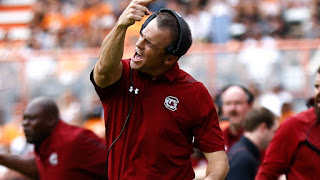Anderson University's plan for football big on ideas, short on details
Editor's Note: For full disclosure, I feel I should mention I was a student at Anderson University my first two years of undergraduate work. I also spent some time covering their athletics department as a professional writer.
The game of football is getting a new team in South Carolina.
On October 4, Anderson University announced plans to start a program during a press conference at the school. Here is a link to the full video.
The school received a $3 million challenge gift from Dr. Melvin Younts, with the goal set to match that total for a $6 million total investment and a hopeful first season set for 2024.
What is currently known is that the team will compete in the South Atlantic Conference (SAC), a Division II conference including Carson-Newman, Wingate, Lenior-Rhyne, Mars Hill, Newberry, Tusculum and Catawba.
Football will also be the second of two men's sports, joining lacrosse which will start in 2021.
This news likely won't shake the ground of the major college football world. The small school with an enrollment of nearly 3,000 is tucked away in the historic district of Anderson, S.C. It does make Anderson the second school in western South Carolina to announce plans to field a team, joining Erskine.
Erskine announced it was reinstating its program with a planned start in 2020.
This is a positive for local Upstate high school players, giving them another avenue to continue their playing careers and open doors academically. There are 15 high school programs in a three-county area within roughly an hour of the school, not including Greenville County to the east and Abbeville and Laurens counties to the south.
There is a fertile recruiting ground right in the school's backyard it would be wise to build its team around, at least initially to get local support.
Also, this gives the school a chance to eventually infuse its athletic department with more money that will ideally not only support the football team, but also trickle to the "non-revenue" sports and help those athletes with better equipment, facilities and coaching.
While there are positives to starting a program, there are plenty of logistical questions that need to be answered in the months moving forward.
For one, where do you put the extra students? The campus is already bursting at the seams and is landlocked for on-campus expansion. The town of Anderson's apartments aren't currently targeted to students.
That could change with investment, but that takes an influx of capital and time.
Another non-football issue is how does the addition of two male sports effect Title IX? This addition should put men's scholarship numbers far ahead of women's. Could we see the addition of one or two more female sports?
To me, adding more women's sports is a positive, but that carries more logistical issues and more investment.
The news of the addition also comes just three years after the school discontinued its wrestling program.
From a football standpoint, the logistics questions are the usual ones when it comes to starting a program: When will a coach be hired? Where will you play home games? How much will equipment costs run? Where will the money come from to compensate travel?
Many of those I imagine will be funded with the projected $6 million investment.
But if $6 million is the cost to start, how much money is needed to maintain and grow?
These are just some of the questions the school must answer either with themselves, or the community, moving forward.
One need only look down the road to Presbyterian College as a cautionary tale. That program is looking to transition to a non-scholarship program after the last few seasons of financial trouble.
Granted, Presbyterian is smaller, with nearly a third the student body as Anderson but were in the Big South, a Division I level conference.
There are also two examples of success in the near area, with Newberry and North Greenville. Both smaller student-bodies than Anderson with limited funds, but both have fielded successful to semi-successful programs.
Newberry of course has been a mainstay in the South Atlantic while North Greenville has been in the Gulf South Conference, also a Divison II-level group. Furman and Wofford, private schools just like Anderson, have also had success, but those two programs have each been around since 1889.
There are a lot of positives to starting a football program at a university. There are also a lot of details that have to be ironed out.
Right now, answers for those details are not known.
The game of football is getting a new team in South Carolina.
On October 4, Anderson University announced plans to start a program during a press conference at the school. Here is a link to the full video.
The school received a $3 million challenge gift from Dr. Melvin Younts, with the goal set to match that total for a $6 million total investment and a hopeful first season set for 2024.
What is currently known is that the team will compete in the South Atlantic Conference (SAC), a Division II conference including Carson-Newman, Wingate, Lenior-Rhyne, Mars Hill, Newberry, Tusculum and Catawba.
Football will also be the second of two men's sports, joining lacrosse which will start in 2021.
This news likely won't shake the ground of the major college football world. The small school with an enrollment of nearly 3,000 is tucked away in the historic district of Anderson, S.C. It does make Anderson the second school in western South Carolina to announce plans to field a team, joining Erskine.
Erskine announced it was reinstating its program with a planned start in 2020.
This is a positive for local Upstate high school players, giving them another avenue to continue their playing careers and open doors academically. There are 15 high school programs in a three-county area within roughly an hour of the school, not including Greenville County to the east and Abbeville and Laurens counties to the south.
There is a fertile recruiting ground right in the school's backyard it would be wise to build its team around, at least initially to get local support.
Also, this gives the school a chance to eventually infuse its athletic department with more money that will ideally not only support the football team, but also trickle to the "non-revenue" sports and help those athletes with better equipment, facilities and coaching.
While there are positives to starting a program, there are plenty of logistical questions that need to be answered in the months moving forward.
For one, where do you put the extra students? The campus is already bursting at the seams and is landlocked for on-campus expansion. The town of Anderson's apartments aren't currently targeted to students.
That could change with investment, but that takes an influx of capital and time.
Another non-football issue is how does the addition of two male sports effect Title IX? This addition should put men's scholarship numbers far ahead of women's. Could we see the addition of one or two more female sports?
To me, adding more women's sports is a positive, but that carries more logistical issues and more investment.
The news of the addition also comes just three years after the school discontinued its wrestling program.
From a football standpoint, the logistics questions are the usual ones when it comes to starting a program: When will a coach be hired? Where will you play home games? How much will equipment costs run? Where will the money come from to compensate travel?
Many of those I imagine will be funded with the projected $6 million investment.
But if $6 million is the cost to start, how much money is needed to maintain and grow?
These are just some of the questions the school must answer either with themselves, or the community, moving forward.
One need only look down the road to Presbyterian College as a cautionary tale. That program is looking to transition to a non-scholarship program after the last few seasons of financial trouble.
Granted, Presbyterian is smaller, with nearly a third the student body as Anderson but were in the Big South, a Division I level conference.
There are also two examples of success in the near area, with Newberry and North Greenville. Both smaller student-bodies than Anderson with limited funds, but both have fielded successful to semi-successful programs.
Newberry of course has been a mainstay in the South Atlantic while North Greenville has been in the Gulf South Conference, also a Divison II-level group. Furman and Wofford, private schools just like Anderson, have also had success, but those two programs have each been around since 1889.
There are a lot of positives to starting a football program at a university. There are also a lot of details that have to be ironed out.
Right now, answers for those details are not known.




Comments
Post a Comment